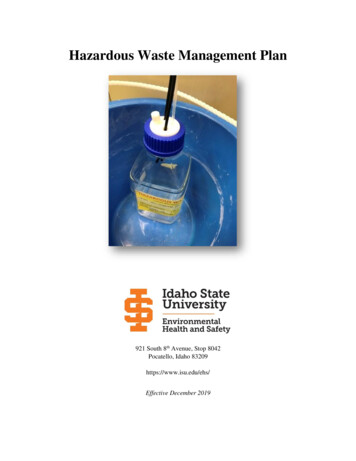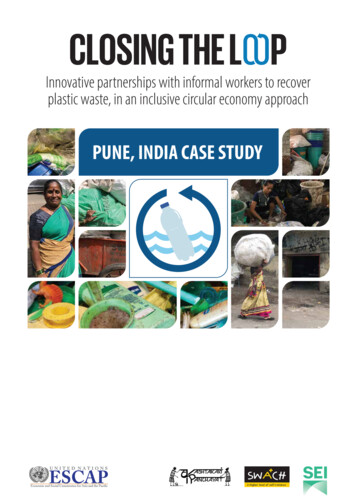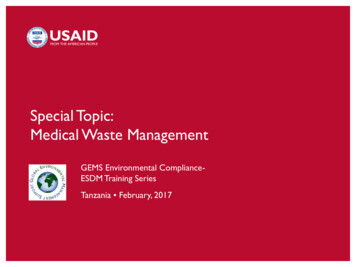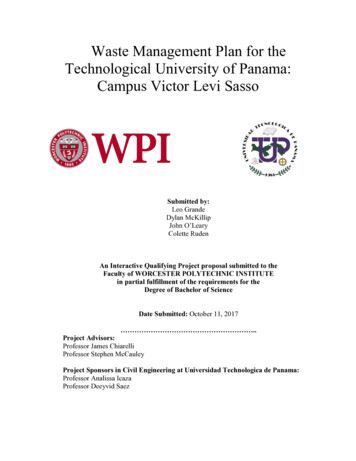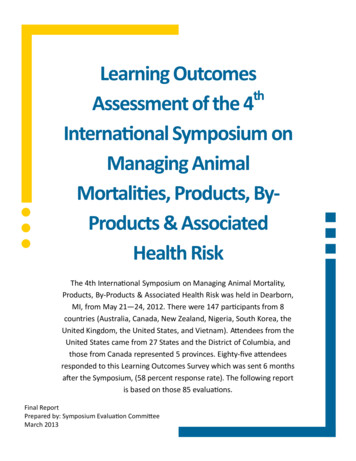
Transcription
Learning OutcomesthAssessment of the 4International Symposium onManaging AnimalMortalities, Products, ByProducts & AssociatedHealth RiskThe 4th International Symposium on Managing Animal Mortality,Products, By-Products & Associated Health Risk was held in Dearborn,MI, from May 21—24, 2012. There were 147 participants from 8countries (Australia, Canada, New Zealand, Nigeria, South Korea, theUnited Kingdom, the United States, and Vietnam). Attendees from theUnited States came from 27 States and the District of Columbia, andthose from Canada represented 5 provinces. Eighty-five attendeesresponded to this Learning Outcomes Survey which was sent 6 monthsafter the Symposium, (58 percent response rate). The following reportis based on those 85 evaluations.Final ReportPrepared by: Symposium Evaluation CommitteeMarch 2013
4th International Symposium on Managing Animal Mortality, Products, By-products and Associated Health Risk—May 2012Learning Outcomes AssessmentTABLE OF CONTENTSExecutive SummaryIntroductionRespondent DemographicsSymposium SatisfactionSymposium ImpactAppendix A: Learning Outcome SurveyAppendix B: Individual Responses to How Information and/or Materials Obtained at theSymposium Have Been UsedAppendix C: Reasons Given for Most and Least Useful SessionsMost UsefulLeast UsefulAppendix D: Additional Comments About the Symposium33447121418182123LIST OF TABLESTable 1: Survey respondent demographics—country and professional affiliation5Table 2: How well the Symposium met the needs of respondents or their organization andhow satisfied respondents were with the information provided5Table 3: How Symposium information/materials have been used8Table 4: The most and least useful sessions as rated by respondents9Table 5: Number of new/renewed partners or collaborators with whom respondents havebeen in contact10Table 6: Number of actions taken by attendees as a result of the Symposium10Table 7: Specific actions taken by Symposium attendees112
4th International Symposium on Managing Animal Mortality, Products, By-products and Associated Health Risk—May 2012EXECUTIVE SUMMARYThe 4th International Symposium on Managing Animal Mortality, Products, By-products & AssociatedHealth Risk succeeded in the following deliverables: Eighty-nine percent of attendees developed new or renewed partnerships and collaborationsfocused on meeting the needs of stakeholders. The Symposium fostered the exchange of technical expertise, best practices, new knowledge,and insights for issues surrounding animal mortality, products, by-products and associated healthrisk. Eighty-seven percent of attendees used materials or gained information and 90 percent tooksome action as a direct result of attendance at the Symposium. Attendance at the Symposium resulted in over half of the attendees working with new partnersand collaborators, over one-third expanding an existing educational program or adapting anexisting research project based on information gained at the Symposium, and over one-quarterexpanding an existing research project.INTRODUCTIONThe 4th International Symposium on Managing Animal Mortality, Products, By-products andAssociated Health Risk was held May 21-24, 2012, in Dearborn, MI. The Symposium, held every 2 to2½ years, brings together government and industry officials, researchers, educators, and otherstakeholders who work with animal mortality, and with depopulation, disinfection, and disposal(3D). These Symposia are held to strengthen collaboration and partnership, share research andstandard operating procedures, and disseminate the newest information to all groups involved inmortality and 3D issues. This Symposium included pre-symposium tours, concurrent sessions,posters, exhibits, plenary and keynote sessions, a cross-border foot-and-mouth disease (FMD)response workshop, and demonstrations. The 2012 Symposium proceedings are available at 12.pdf and the presentations are available at 2012.pdf.The Symposium evaluation process was designed to assess the following: How well the Symposium encouraged the development of new or renewed partnerships andcollaborations focused on meeting the needs of stakeholders. How well the Symposium fostered the exchange of technical expertise, best practices, newknowledge, and insights for issues related to animal mortality, products, by-products, associatedhealth risks, and 3D. How many participants learned and adopted new or existing methodologies and resources fordealing with mortality and 3D issues. The planned and actual impacts of the Symposium.3
4th International Symposium on Managing Animal Mortality, Products, By-products and Associated Health Risk—May 2012 Basic feedback on the Symposium that will be shared with the funders and future Symposiumplanning committees.The Symposium evaluation was performed in two stages:1. An end of Symposium evaluation was conducted using the participant-completed hard-copyevaluation forms collected during the Symposium.a. Results of this evaluation have been summarized in the “Evaluation Report Synopsis”submitted to the Symposium planning committee on November 16, 2012.b. Seventy-nine of the 147 Symposium attendees filled out the hard-copy evaluation forms.c. This evaluation indicated that the Symposium encouraged the development of new andrenewed partnerships and collaborations, fostered the exchange of technical expertise andallowed for new knowledge and insights on animal mortality, products, by-products,associated health risks, and 3D issues. Participants learned about new and existingmethodologies and resources that would be taken back with them to their respectivecountries, jobs, etc. and put to use.d. Critical gaps in research, outreach, policy, and response capabilities that still need to beresolved were identified and suggestions were made for the next Symposium.2. The Learning Outcome Survey (appendix A) was e-mailed six months after the Symposium to allparticipants to evaluate learning outcomes, the efficacy of the Symposium in enhancingknowledge, and changing attitudes and behaviors. The following is a summary of this survey.RESPONDENT DEMOGRAPHICSEighty-five (57.8 percent) of the 147 Symposium attendees responded to the Learning Outcomesurvey. The majority of respondents were from the United States (table 1), representing 24 States andWashington, DC. The rest of the respondents were from Canada (four provinces), Australia (threeregions), Nigeria, and the United Kingdom. Professional affiliation is also shown in table 1. Thirty-eight(45 percent) of the respondents were government affiliated and 30 (35 percent) were affiliated withan educational institution. The remaining 17 included 11 (13 percent) from the private sector, 4 (5percent) with non-governmental organizations (NGOs), and 1 (1 percent) each with an internationaldevelopment agency and a research institute. Respondents to this survey were affiliated somewhatdifferently than the hard-copy survey where 59 percent were government employees, 17 percentwere from an educational institution, 11 percent were from a research institute, 7 percent were fromthe private sector, and 5 percent were from an NGO.SYMPOSIUM SATISFACTIONRespondents were asked two questions to gauge their satisfaction with the Symposium: 1) Did theSymposium meet your or your organization’s needs? 2) How satisfied were you with the informationprovided at the Symposium? Table 2 shows the answers to both questions.4
4th International Symposium on Managing Animal Mortality, Products, By-products and Associated Health Risk—May 2012Table 1: Survey respondent demographics—country and professional affiliation (n 85)CountryAffiliationNumberGovernment of public enterpriseAustraliaCanada44Educational institution321.4Government or public enterprise535.7Non-governmental organization214.3Private sector428.6Total Canada14Educational institution2Total Nigeria2Educational institution1United KingdomTotal United Kingdom4.716.5100.02.4100.012.4Educational institution2437.5Government or public enterprise2945.3International development organization11.6Non-governmental organization23.1Private sector710.9Research institute11.6Total United StatesPercent ofrespondents100.0Total AustraliaNigeriaUnited StatesPercent ofcountry6475.3Over half of respondents indicated that the Symposium completely met their or their organization’sneeds; almost half indicated they were completely satisfied with the information provided at theSymposium. No one indicated that needs were not met. Two indicated that they had no objectivesfor attending the Symposium. Six respondents specifically commented on whether or not theirTable 2: How well the Symposium met the needs of respondents or their organizations (n 82) and how satisfiedrespondents were with the information provided (n 85)Needs tely satisfied4249.4To some extent2834.1Satisfied4148.2Not at all00Neither satisfied nor dissatisfied33.5Had no objectives22.4Dissatisfied00Completely dissatisfied005NumberPercent
4th International Symposium on Managing Animal Mortality, Products, By-products and Associated Health Risk—May 2012needs were met.From two that did not answer the question: “I was at only one day of the Symposium and I’m not sure what our “needs” are. Several of usattended various sessions and one later went to the composting educational week in Maine. Ithink we all enjoyed the Symposium and brought back a lot of good information.” (United States,government or public enterprise) “I worked at the Symposium and did not attend any meetings.” (United States, government orpublic enterprise)From two that answered “to some extent”: “Nothing ever meets our needs completely so that’s too high a standard to set. It was a greatmeeting with important and timely talks and opportunities to network.” (United States,educational institution) “I felt that the Symposium was very well done, and I appreciated the updates on new research incomposting. While many questions were answered, new ones were posed, which is why Icannot, in full honesty, say that all our needs were met. However, I truly appreciated theopportunity to learn new questions to ask.” (United States, government or public enterprise)From two that answered “completely”: “There was a good variety of topics covered and a lot of opportunity to meet people in this field,with an extraordinary international perspective. The only thing that was not so good was thatthere were concurrent sessions in which I would have liked to be able to attend allpresentations.” (United States, educational institution) “The Symposium provided new information on animal mortality and stimulated development ofcollaborations with the Department of Ag in developing new procedures for managingemergencies involving animal mortalities, and the development of new educational programs inthe coming year.” (United States, educational institution)Twenty-six people provided additional comments when completing the survey. These commentsranged from reasons why this Symposium was good to general observations about the logisticalmanagement of the Symposium and suggestions for the next one. All of these comments can befound in appendix D. Overall, feedback on the organization and content of the Symposium waspositive indicating that the planning committee did a good job. There were a few specificsuggestions on the Learning Outcomes survey for consideration now and at the next Symposium:1. “I would appreciate seeing a summary of the [cross-border FMD] workshop findings placed onthe Symposium website.”2. “I look forward to more African participants at the next symposium. African researchers shouldbe carried along in these emerging and very important discussions that border on human, animaland environment. Salvaging the problem of disease outbreak requires collective efforts ofresearchers all over the world. Disease does not recognize boundaries/borders of local, state,6
4th International Symposium on Managing Animal Mortality, Products, By-products and Associated Health Risk—May 2012country and continents. I am of the view that where possible, participants from Africa should beencouraged to attend this all-important Symposium by providing them with seed grant tocushion the cost of their participation. In addition, participants should be presented withcertificate of participation at the end of the Symposium. In all, the planning, organization, andexecution of the symposium were quite commendable. I look forward to future events!”3. “I think that tours and demonstrations are great for this symposium and the next location shouldbe prioritized based on both.”4. “I would like to see more people there to be able to plan for events; I think there are still majorgaps when we have disasters with livestock losses. I also think that we have put ourselves intoalarming situations to maximize profit over sustainability when borders will close at some pointsin time for whatever reason.”Based on respondents’ experiences at this Symposium, 89 percent said that they would attend thenext Symposium. Of the remaining nine answers, seven said they would not attend and two saidthey may attend. The number of respondents who said they would attend again is slightly lowerthan the 95 percent who indicated on the hard-copy survey they would recommend the Symposiumto a colleague.SYMPOSIUM IMPACTThe Learning Outcomes Survey asked a series of questions designed to assess the long-term impactof the Symposium. (See questions 5 to 10 in appendix A). Of respondents to the question asking “ifthe information had been used,” 87 percent indicated they have used information presented at theSymposium, 12 percent said they had not and one person indicated she had not yet used any, butprobably will in the future. Of the 73 respondents that answered yes, 60 explained how theinformation was used. These responses were tallied by sorting into the following categories:Collaboration, Education/Outreach, Planning, Policy, and Research.Table 3 shows the number of responses, the percentage of people using the information, and thepercentage of responses in each of the categories in which the information obtained at theSymposium was used. Individual responses, including country and affiliation of the person whoanswered, can be found in appendix B. The category in which the information and/or materials weremost used was in education and/or outreach. Fifty-five percent of the people who indicated thatthey had used information and materials from the Symposium said that it had been used foreducational purposes.Over one third of respondents (12 of 33) used information gleaned on composting in one way oranother and about one-quarter (8 of 33) indicated that general disposal information (one or more7
4th International Symposium on Managing Animal Mortality, Products, By-products and Associated Health Risk—May 2012methods) had been incorporatedinto lectures or delivered to ordiscussed with colleagues, clients,Number ofPercent ofPercent ofor stakeholders. on and materials wereCollaboration610.08.3used for planning, for policy, and forEducation/Outreach3355.045.8research by 11 people (18 percent)Planning1118.315.3in each category. For planning, eightPolicy1118.315.3respondents were governmentResearch1118.315.3employees who used information tohelp set priorities or to better understand procedures available for disposal. In the policy category,7 of 11 respondents used the information to revise to or to add to current policy. In the researchcategory, new or revised research was performed by people from four of the five countries and fourof the six professional affiliations represented by this survey. When asked if they would continueusing the information or materials, only 1 of the 72 said no.Table 3: How Symposium information/materials have been used (60people gave 72 responses)Most respondents said they had discussed or shared information with others. Only 4 of 82respondents said they had not discussed or shared the information with others; all of them camefrom the United States (2 were affiliated with educational institutions and 2 with government orpublic enterprise).Attendees were asked to pick the three sessions at the Symposium that were most and least usefulto their work, even if they did not they actually attend the session (table 4). The question wasintended to gain an understanding of the topics and/or delivery methods that would have thegreatest impact on the largest number of people in the field. However, respondents were reluctantto “rank” sessions with one specifically saying “I’d prefer not to rank in this manner. Eachpresentation delivered ’nuggets‘ of useful information. To rank is to compare apples to oranges.”Therefore, although 70 respondents identified the most useful sessions, only 50 identified the least.One person, who picked only the most useful said, “Honestly, and this is a rare thing, I found allsessions useful to some extent“. Table 4 shows the results of this question (answers were notranked as 1, 2 and 3 but as equally useful or not useful for each respondent).Breakout session 5, Animal Mortality Composting, was the most useful session according to 39percent of respondents. Reasons given for this session’s usefulness included: Content: Three attendees indicated that the content of this breakout session made it the mostuseful as indicated by the following comment: “Animal mortality composting was entirely new8
4th International Symposium on Managing Animal Mortality, Products, By-products and Associated Health Risk—May 2012Table 4: The most and least useful sessions as rated by respondentsMost useful (n 70)Least useful (n 50)NumberPercentNumberPercentPre-Symposium Tour A—CIFA Import Station811.4816.0Pre-Symposium Tour B—Rendering68.6816.0Pre-Symposium tour C—MSU Research and Education912.948.0May 22 Keynote—Don Klingborg34.3612.0May 22 Plenary—Gary Flory68.648.0Breakout Session 1—Emergency Response and Policy1825.7612.0Breakout Session 2—Alternative/Mechanical Disposal57.148.0May 22 Plenary—Juan Reyes34.3918.0Breakout Session 3—Environmental Effects of Disposal2028.648.0Breakout Session 4—Depopulation, Decontamination/Disinfection & Recovery912.948.0May 23 Keynote—Dr. Heekwon Ahn1927.1612.0May 23 Plenary—Dr. Steven Halstead34.348.0Breakout Session 5—Animal Mortality Composting2738.636.0Breakout Session 6—Depopulation, Decontamination/Disinfection & Recovery1825.712.0Breakout Session 7—Policy and Education34.31632.0International Panel57.1714.0Breakout Session 8—By-products and Foods of Animal Origin22.91428.0Poster Session22.91326.0Cross-border FMD response nMay 23 Plenary—Tom Glanvilleto me and I am very optimistic that it is a technology which when acquired and perfectedthrough training and retraining of experts in Nigeria will help handle large-scale animal mortalityin my country.” Direct correlation with position or job: Six attendees indicated their job or position made thissession most useful as shown by the following comment: “As a manufacturer of in-vesselcomposting equipment primarily focused on the animal mortality industry, it is beneficial to keepup with the latest advancements in animal mortality composting and animal by-product disposalmethods.”Approximately one-quarter of respondents felt that breakout Sessions 1, 3 and 6, as well as Dr.Ahn’s keynote address, and the cross-border FMD response workshop, were the most usefulsessions for their job or position. Thirty-four respondents gave reasons for their choices and thesecan be found in appendix C. In most cases, the reason for a session’s usefulness was either that the9
4th International Symposium on Managing Animal Mortality, Products, By-products and Associated Health Risk—May 2012content was informative or interesting (13 of 34), or the subject matter had a direct correlation withthe respondent’s position or job (15 of 34). The FMD workshop and demonstrations were cited asuseful not only because of content but also because of the method of information delivery. Sessionsrated as least useful were so rated because they did not directly correlate with the respondent’sposition, job, or interests. Other than the poster session, which 26 percent indicated was least usefuland only 3 percent said was most useful, the results of this question give equal “most” and “least”useful for each session, which indicates that there was a good mix of sessions for the varied interestand positions of all attendees.Table 5: Number of new or renewed partners or collaborators withwhom respondents have been in contact (n 85)Number of partners/collaboratorsNumber ofresponsesPercent ofresponsesNone1011.8One to two3642.4Three to five2934.1Greater than five1011.8Table 5 shows how many new orrenewed partners or collaboratorsrespondents have been in contactwith since the Symposium. As morethan 75 percent of respondentsindicated they have been in contactwith between one and five new orrenewed partners, it appears theSymposium successfully establishedcontacts and helped withcollaboration.The last question asked to assessTable 6: Number of actions taken by attendees as a result of theSymposium impact had respondentsSymposium (n 83)check off statements that describedNumber ofPercent ofNumber of actionstheir actions as a result of attendingresponsesresponsesthe Symposium. Forty-five of the 83910.8Nonepeople (54 percent) who answered2024.1Onethis question reported doing 1 or 22530.1Twoof these actions as a result of the1518.1ThreeSymposium (table 6) and 35 percent78.4Fourreported doing 3 or more.10Five44.8Six22.4Seven11.2
4th International Symposium on Managing Animal Mortality, Products, By-products and Associated Health Risk—May 2012Table 7 shows the specific actions and the number of respondents that undertook each. More thanhalf of those answering the survey indicated that as a result of attending the Symposium, they“identified one or more partner(s) or collaborator(s) to work with this year”. Almost half indicatedthat they “adapted an existing program/project based on information gained”. One quarter or moreof the respondents indicated that they had completed each of the following: “expanded an existingeducation or outreach program”, “expanded an existing research project” and/or “adapted anexisting program/project to better meet the needs of stakeholders”. The fact that all of theseactions were taken indicates that the Symposium had a very positive impact on the attendees. Twopeople specifically identified their actions: A Canadian government employee: “Identified areas for potential enhancement; confirmedmuch of what we are already doing. Used information to support funding of a researchproposal. ” A United States educational institution employee: “There was a question about how hot thebone marrow got during composting. We had the opportunity, because a cow was being putinto a compost pile in another project, to drill into the bone and place temperature probesthere to record what was happening inside the bone. ”Table 7: Specific actions taken by Symposium attendees (n 83)ActionNumber ofresponsesExpanded an existing education or outreach program3036.1Designed and implemented a new education or outreach program56.0Completed a funding request for a new or existing program89.6Expanded an existing research project2226.5Designed and implemented a new research project89.6Completed a funding request for a new or existing research project67.2Identified one or more partner(s) or collaborator(s) to work with this year4857.8Adapted an existing program/project based on information gained3643.4Adapted an existing program/project to better meet the needs of stakeholders1922.911Percent ofresponses
4th International Symposium on Managing Animal Mortality, Products, By-products and Associated Health Risk—May 2012APPENDIX A: LEARNING OUTCOME SURVEY1. Please indicate where you are from by filling in the boxes belowa. Countryb. State/Province/Region2. What is your professional affiliation?a. Government or public enterpriseb. Research institutec. Private sectord. Educational institutione. Non-governmental organizationf. International development agencyg. Other (please specify)3. Did the Symposium meet your or your organization’s needs?a. Completelyb. To some extentc. Not at alld. Had no objectivese. Other (please specify)4. How satisfied were you with the information provided at the Symposium?a. Completely satisfiedb. Satisfiedc. Neither satisfied or dissatisfiedd. Dissatisfiede. Completely dissatisfied5. Have you used any of the information and/or material(s) provided in your job?a. Yesb. No6. If the answer to question 5 is “yes”, please give details of use.7. Do you expect to continue to use this information/material(s) in the future?a. Yesb. No8. Have you discussed and/or shared the information with others?a. Yesb. No12
4th International Symposium on Managing Animal Mortality, Products, By-products and Associated Health Risk—May 20129. With how many new or renewed partners or collaborators have you been in contact since theSymposium?a. Noneb. 1 – 2c. 3 – 5d. 510. Please place a check next to each of the below statements that describe your actions as a result ofthis Symposiuma. Expanded an existing education or outreach programb. Designed and implemented a new education or outreach programc. Completed a funding request for a new or existing programd. Expanded an existing research projecte. Designed and implemented a new research projectf. Completed a funding request for a new or existing research projectg. Identified one or more partner(s) or collaborator(s) to work with this yearh. Adapted an existing program/project based on information gainedi. Adapted an existing program/project to better meet the needs of stakeholdersj. Other (please specify)11. From the drop down menu please select the three most AND the three least useful sessions foryour work (which you may or may not have attended) and briefly explain the reason for each inthe text box that follows. The box below included a drop-down list of the Pre-Symposium tours, keynotes, plenarysessions, breakout and poster sessions, FMD workshop and the demonstrations. Respondents simply picked from thelist.Most UsefulLeast UsefulSession 1Session 2Session 312. Based on your experience at this Symposium, would you like to attend the next one?a. Yesb. Noc. Other (please specify)13. Please use the space below for any additional comments/suggestions you would like to make.13
4th International Symposium on Managing Animal Mortality, Products, By-products and Associated Health Risk—May 2012APPENDIX B: INDIVIDUAL RESPONSES TO HOW INFORMATION AND/OR MATERIALSOBTAINED AT THE SYMPOSIUM HAVE BEEN USEDCollaboration1. Engagement with waste management industries on topics presented at the symposium(Australia, government).2. New technologies reviewed and discussed with colleagues (Australia, government).3. Provided at least one more contact for information and potential collaboration (Canada,government).4. Sharing the information that was presented (Canada, government).5. Working with people I met through attending the program (United States, educationalinstitution).6. Contacts were important (United States, educational institution).Education/Outreach1. Review of emergency disease animal disposal manual (Australia, government).2. Have used some of the information for international travels and seminars on carcass disposalmanagement (Canada, educational institution).3. Student discussions and grant proposal (Canada, educational institution).4. The conclusions of the FMD table top have been fed into exercises here and into discussionsregarding cross jurisdictional management of an outbreak as well as capacity and resourcesissues regarding decontamination needs (Canada, government).5. The idea on composting and emergency response to dead animal carcass disposal forms part ofmy undergraduate lecture in my Institution (Nigeria, educational institution).6. Used some of the knowledge in lectures and when liaising with policy-makers that are involvedwith animal by-products disposal (United Kingdom, educational institution).7. I've used information presented on burial in publications and presentations. I've also sharedinformation on rendering that I learned more about. I gained further knowledge on compostingand its effects on drug residues (United States, educational institution).8. I used information on size reduction and alkaline hydrolysis for my Extension presentation onmortality composting (United States, educational institution).9. Referenced the proceedings and used information presented in my own presentations toproducer and agriculture service provider groups (United States, educational institution).10. Working with a couple of farms setting up on-farm mortality composting. Also, planning anarticle for our newsletter (United States, educational institution).11. Carcass disposal options were presented. Knowing these options is important when we arediscussing euthanasia with others. We are involved in mass euthanasia programs as well asindividual animal (United States, educational institution).12. Used the material on the Korean FMD outbreak and the Canadian study suggesting cleaning is14
4th International Symposium on Managing Animal Mortality, Products, By-products and Associated Health Risk—May 2012most important aspect of cleaning and disinfection (United States, educational institution).13. Use info in teaching from many sessions (United States, educational institution).14. Information was used in assisting master's student with literature review and refining of hercomposting project (United States, educational institution).15. Made educational presentations (United States, educati
existing research project based on information gained at the Symposium, and over one-quarter expanding an existing research project. INTRODU TION The 4th International Symposium on Managing Animal Mortality, Products, y-products and Associated Health Risk was held May 21-24, 2012, in Dearborn, MI. The Symposium, held every 2 to







